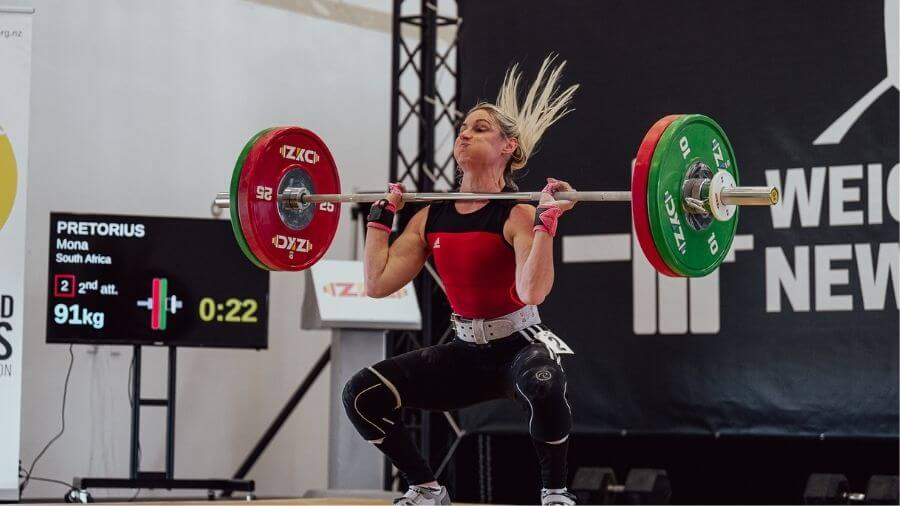There is an ongoing debate about whether you should hang clean (or use any Olympic Weightlifting movement) for MMA. Some say you can get better results with other methods, while others swear by the effectiveness of an exercise like the hang clean.
Hang cleans are good for MMA if you can perform them correctly with great technique and violent speed and power. They are not suitable if you lack mobility and technical nuance.
Olympic lifting for MMA may require a significant time investment to learn. However, it can be well worth it for unreal strength, speed, and power gains.
Are Hang Cleans Good For MMA?
Most exercises serve a purpose for MMA. Hang cleans are no different and can be an excellent tool for developing explosive power to transfer to powerful punches and takedowns. However, I prefer the hang power clean for MMA fighters as you can produce greater speed and power outputs.
Hang cleans heavily recruit the hamstrings, glutes, and back musculature targeting rapid force production with heavy loads [2]. I believe the hang clean transfers well to grappling in the cage, where you need the ability to move other human beings forcefully.
Further, it enhances vertical force production, which is crucial for improving striking power. For example, those with a greater hang power clean 1RM also have a greater 1RM front squat and produce more power during the vertical jump [1].
Hang Clean vs. Hang Power Clean – What’s The Difference?
Many people confuse the hang clean and hang power clean as the same exercise. However, they are distinctly different and used for various purposes. The main difference is the hang clean is caught in the bottom of the squat position while the hang power clean is caught anywhere above parallel.
The higher catching position of the hang power clean means you need to pull the bar higher and, therefore, need to generate greater bar speed and power.

How to Dominate Every Fight with Raw, Explosive Power No One Can Match
Discover the underground blueprint that has quietly turned MMA hopefuls into legends, using nothing but sheer, brute force and bulletproof conditioning techniques.
How To Hang Power Clean
Instead of teaching you how to hang clean, I will show you the hang power clean. I prefer the power variation over the hang clean because of the added speed and power needed to catch the bar in a higher position.
International Weightlifter Mona de Lacey has detailed an epic technique breakdown of the hang power clean you can check out here.
Starting Position
You will start with the barbell just above the knee. You will deadlift the barbell to the hip, then find the above-knee hang position to get there. In this position, your bodyweight should be through the middle of your feet. Not on your toes or your heels.
This is what makes the hang position entirely different from the Romanian deadlift. If you push your hips back and have your weight through your heels, your hang power clean will suffer.
Your shoulders will be over the bar as you maintain a big chest and tight lats. Keeping tension in your lats will ensure the bar stays close to your leg. Your elbows will point to the side, which will make sure the bar travels vertically and doesn’t loop around.
The Pull
Initiate the pull by pushing with the legs. Many make the mistake of lifting the shoulders and back first, which moves you out of position. You want to stay over the bar as long as possible until you are standing vertically.
The bar will brush up your thighs, not bounce off them. As the bar brushes up your thighs, fully extend onto your toes with a big shrug of the shoulders. At this point, pull the bar with your arms like an upright row.
The Catch
At the top of the pull, rapidly rotate your elbows under the bar and get them as high as possible in front of you. Your feet will move laterally, and you’ll land with bent legs, ready to receive the bar. You should catch the bar on your shoulders with the barbell against your neck.
Should You Hang Clean For MMA?

Whether you use the hang clean for MMA or not depends on the time you have to learn the exercise and your current gym training age. Here is where I believe it would be beneficial for you to learn the hang clean or hang power clean:
- You’ve spent 1-2+ years in the gym and have developed a base level of strength, power, and movement coordination.
- You don’t have a fight within the next six months.
- You thoroughly enjoy Olympic Weightlifting and want to learn the hang clean.
- You have no injuries that prevent you from getting into important positions.
If you tick these boxes, go ahead and find a coach that can teach you the hang clean. Trying to learn it yourself is typically a recipe for disaster.
However, the hang clean is not necessary to develop strength, speed, and power for MMA. You have many other practical options with various jumps and throws. One excellent substitute is the jump squat.
Summary
The hang clean can be an excellent exercise for MMA when done correctly. However, MMA fighters are not Weightlifters and, therefore, are not required to do this exercise. There is no harm in learning the movements if you enjoy it, want to learn, and have the time. But going to your local CrossFit box and smashing out multiple reps with 95 lbs isn’t the answer.
References
1. Hori, N., Newton, R. U., Andrews, W. A., Kawamori, N., McGuigan, M. R., & Nosaka, K. (2008). Does performance of hang power clean differentiate performance of jumping, sprinting, and changing of direction?. The Journal of Strength & Conditioning Research, 22(2), 412-418.
2. Ronai, P., & Scibek, E. (2016). The hang power clean. ACSM’s Health & Fitness Journal, 20(5), 50-55.

